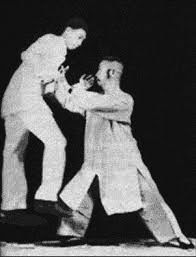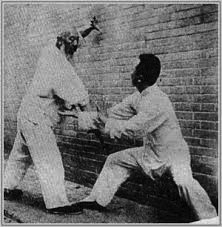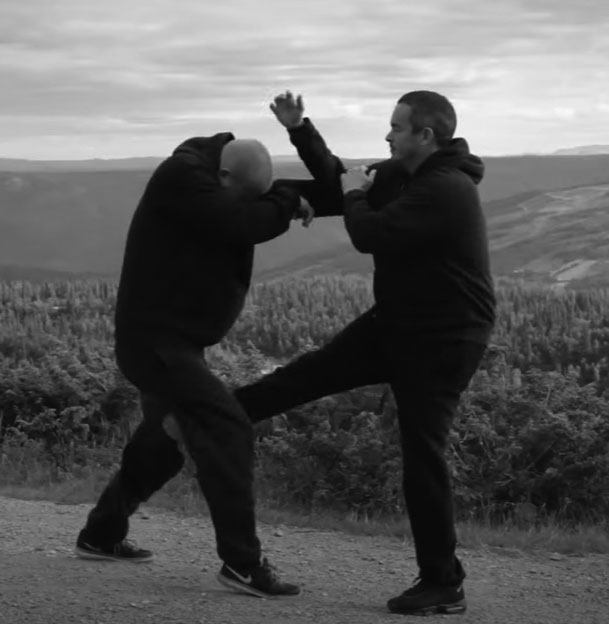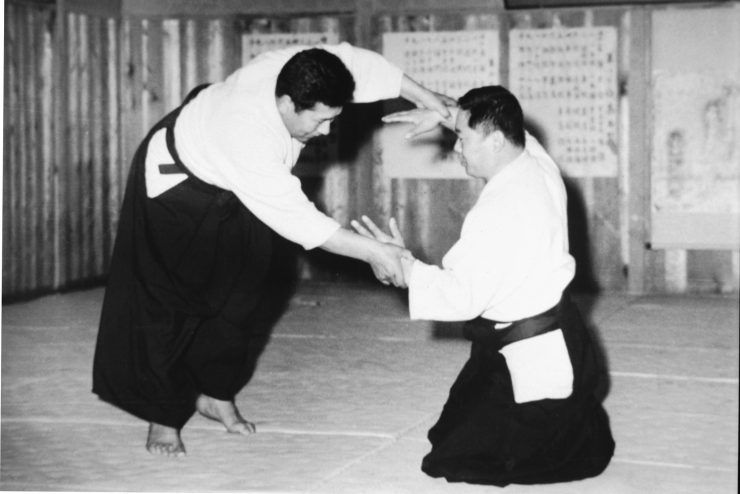I have had the opportunity to meet a lot of martial artists from different disciplines. In this article we are going to look at a certain subset of individuals, specifically those interested in the 'internal arts' or Aiki arts. There is much mystery, misconception and indeed ridicule surrounding these ‘internal’ systems and they are often linked to MartialBody training due to my personal training in them. So if you are not from these arts this article may not make much sense but it could be an entertaining dive into that world none the less.
 I am compelled to write this article due to some recent experiences coaching people from these arts. You see, these arts are renowned but in two, polar opposite ways. Firstly, to the majority of the world who have heard of things like Internal Power or Aiki - they are known for nonsense. This is something that the Internal Arts world needs to accept and address. They are known for people hopping around, falling over at the slightest touch (or no touch at all) and all of the various 'tricks' that abound mocking martial arts sites and YouTube channels. If we are practitioners of the Internal Arts we have to accept this reality.
I am compelled to write this article due to some recent experiences coaching people from these arts. You see, these arts are renowned but in two, polar opposite ways. Firstly, to the majority of the world who have heard of things like Internal Power or Aiki - they are known for nonsense. This is something that the Internal Arts world needs to accept and address. They are known for people hopping around, falling over at the slightest touch (or no touch at all) and all of the various 'tricks' that abound mocking martial arts sites and YouTube channels. If we are practitioners of the Internal Arts we have to accept this reality.
However, they are also known to a very select few, as some of the most 'powerful' systems of martial arts that one can encounter. This is a reality that many will never know or even experience. Indeed, even those who believe that they are experiencing it, often are not!
These two aspects of internal arts and related practices are, to all intents and purposes, self-cancelling. If one holds the first view they will never believe the second reality until they feel it. Similarly, if one believes the second view they may be (and often are) susceptible to the nonsense that is mocked in the first. This dichotomy is telling and pernicious in the way that it spreads in these arts. Often there is a charismatic and highly skilled person at the top, and either their skill will trickle down - or their nonsense will.
But I should begin by looking at what people from these arts often actually expect and want. There are of course a multitude of reasons that someone may be drawn to the internal arts. Some may be in love with the history, the tradition and the culture found in these systems, some may want to improve their health and explore their inner world.
However, having met hundreds of internal arts practitioners and spoken to hundreds more, I can say that the fascination with these systems is often rooted in the claims that they are founded upon. These arts are filled with tales of masters pinning people with one finger, Uke's not knowing how they ended up on the ground, of being flung 20 feet from soft touches etc. These are the stories that modern exponents often try to replicate and obsess over.
These are also the skills that very often people force themselves to believe when they touch a teacher or exponent. As an example, I once had an Aikido Dan Grade come to train with me. I had to work hard to train him out of his ‘uke’ ways and back into some sense of stability in practice. Eventually he moved away close to one of my old teachers so I introduced them. In their first meeting he reported that I could ‘Send electric type shocks up his arms’ or that I ‘could pin him with one finger’. My old teacher messaged me very impressed! But I had to confide that I could do no such thing and it was all in his mind.
One of the more lofty goals sought by certain sections of the internal arts community is the ‘Soft Skill’. That is to say that one can utterly control the opponents balance and structure with little to no obvious movement and no perception of force. This famous 'soft touch' that controls the opponent entirely is perhaps a lofty goal - but frankly, its also a wholey unimpressive one! Let me explain why I think this with a couple of stories.
Meeting Internal Arts Masters
 Firstly, I will talk about the first time I met a truly skilled internal arts master. I had already been training in Tai Chi and Aiki JuJutsu for a number of years, but this was a meeting that changed my understanding of what the Martial Arts were and what was possible. However, it is certainly wasn't what advocates of soft skill would recognise.
Firstly, I will talk about the first time I met a truly skilled internal arts master. I had already been training in Tai Chi and Aiki JuJutsu for a number of years, but this was a meeting that changed my understanding of what the Martial Arts were and what was possible. However, it is certainly wasn't what advocates of soft skill would recognise.
I had been training in the Japanese arts for quite some time, as well as some sporting arts and Taiji at a local school after seeing a demonstration of fighting Taiji on a documentary series. The teacher in this documentary was small but blisteringly fast and his big western student stated that he was able to inflict great damage with his skill. I went to visit this western student, at the time to learn Bagua. I was a seasoned doorman at this point, and was using my martial arts in real life encounters every weekend against larger, often armed or multiple opponents.
My first engagement with the teacher was immediately eye opening. I could not do ANYTHING to him. When I say this it is not hyperbole or some tall tale, it is the reality of the encounter. He felt unbelievably strong and powerful. Let me state again that they FELT unbelievably strong and powerful - unstoppable even!
Yes - I could feel his power - it was not light, it was not nothingness, it was not minimal - it was BIG and SCARY! If he wanted to go somewhere I could not stop it, if he wanted to hit me I could not stop it, if he wanted to throw me I could not stop it. But it didn’t feel soft at all. It felt powerful, painful, heavy and stunning. There was no room to defend, no opportunity to counter and my entire structure was compromised.
Let me re-iterate the point here, this individual felt strong. I would later learn to feel strong myself using internal training and it would become clear that the softness was actually inside me, while to the opponent, they felt extreme strength. The beautiful thing about this encounter was that it was not based in 'wrist grabs' or set up conditions. I could literally try anything but it didn’t matter. This master was not sweating, using effort or breathing heavy - he was using a different kind of strength a strength that allowed him to use his whole body at all times to produce shocking, massive forces that were not able to be countered.
I would later learn that the way this individual felt, and the way I myself would develop to feel, would be completely antithetical to the individual interested in the soft unbalancing 'aiki' type internal skill. Indeed, many of those same individuals would believe it to be 'just strength' – even though they could not stop it.
But what of the other side of things? I have, of course, met many teachers with the 'soft' approach. I went to meet an exponent of Aiki who was known to have some skill in this regard. This individual had videos of them throwing people with slight touch or the lightest flick of the wrist. When I grabbed this persons wrists as instructed, and as I had done a thousand times in Daito Ryu, I did so deliberately minimising my own body skill, as is the strange expectation of an Uke. I was unbalanced.
I hardly perceived the action that caused me to take a step, it was very light and very subtle. I certainly wasn’t thrown around like the students, but I took a step and to me that was already a sign that this teacher could manipulate structure and balance very well indeed! It was impressive from a certain point of view. But I soon reframed it. So what if I took a step! Humans evolved to step!
In the next opportunity to contact the teacher, I changed the game very slightly, I wanted to see how practical this skill was in the momentary changeability of an intelligent grip. I gripped with a spiralling type of power known from Xing Yi Quan and held my centre out of reach. Now the teacher could not move me at all, began using muscle and got very frustrated. I said ' I am not trying to be awkward', after all I wasn’t, but was shunned for the rest of the session none the less.
For the third story, I went to meet a Taiji exponent. Again very skilled and considered a high level master. This individual, again, was throwing people around like rag dolls - there was even footage of him moving students without touch. Again, I was instructed to perform a specific technique/method, once again I was a good uke and again I was made to step - as I did so he slapped my stomach. This chap had power, no doubt. As before it was the lightest of touches that took my balance and gave the opportunity to strike.
Once again however, the next time I when asked to perform a different technique or method, I did so taking great care to maintain my body method. This time the teacher had to completely abandon what they were doing and change, as they changed I folded my elbow which caught the teachers cheek lightly. It would have been an interesting continued exchange had the moment been right. As it was I simply stopped and accepted the end of the technique to save the teachers face in front of the seminar participants. Next the teacher asked me to attack a certain way again – this time I reverted back to being compliant but the teacher was annoyed, applied a wrist lock broke a bone in my wrist. I did not make a big fuss, I have broken a lot of bones and it really didn’t hurt too much. The key point of this story was that in the flow of exchange any idea of ‘soft’ work vanished and the teacher reverted to hard methods or cheap attacks.
Which was ‘Internal Skill?’
So back to the subject at hand, which of these three situations were demonstrations of Internal Power and what are their merit. Ultimately which was more impressive? For so many the second or third examples of unbalancing are the more impressive ones. These examples show that from the lightest touch unbalancing is possible. While for others the extreme power of the first example reigns more impressive. Let me tell you clearly. The first example was internal power. The second example was ... something else. The third example was somewhere in between.
If we are to rest on the tales of the old Internal Arts Greats and their feats we have to put ourselves in the shoes of those they faced. What did it actually feel like to receive a Beng Quan from Guo Yun Shen? What did it actually feel like to stand across from the mean and extraordinarily powerful Sokaku Takeda? The greatest internal arts masters couldn’t kill with unbalancing, they couldn’t maim and destroy their opponents in few moves with 'light touches' - they destroyed their opponents with crushing unstoppable forces. The famous Guo Yunshen of Xing Yi Quan Killed people with his 'Crushing Fist' technique, reportedly collapsing their rib cages. You think this was light? THIS is the internal power that was famed and feared across China. Similarly Sokaku Takeda or Gozo Shioda weren't snapping limbs and concussing people without them feeling it.
 Similarly the top students of the teachers I met and respected were all fighters, they all had extraordinary power and you wouldn’t want to be on the receiving end of their technique. I have witnessed some of these students manhandle a particularly rude ‘Aiki’ exponent with ease – an Aiki exponent that would then be handed a high dan grade and proclaimed to be an very skilled in Aiki! Sokaku would turn in his grave!
Similarly the top students of the teachers I met and respected were all fighters, they all had extraordinary power and you wouldn’t want to be on the receiving end of their technique. I have witnessed some of these students manhandle a particularly rude ‘Aiki’ exponent with ease – an Aiki exponent that would then be handed a high dan grade and proclaimed to be an very skilled in Aiki! Sokaku would turn in his grave!
Over time those that train in the ways of unstoppable power learn to metre it - to hide it and not show it to people they touch, safe in the knowledge that if they let go it would break people. As my power was growing I once struck my teachers arm with a whole body strike from a few inches away, 30 seconds later it looked like there was half a purple tennis ball protruding from his forearm and practice had to stop. At that point I started to train to the control depth and force behind my methods for fear of making a similar lump - but under the flesh. Over time hiding the skill and metering the power became easier just as my teachers would always do with me. Every time I have shown the unstoppable power to someone who comes to me from the internal arts, their face changes, they put their hands up in fear. That is internal power.
Let me re-iterate, internal skill should feel unstoppable - None of the good teachers I met, nor their students would ask you to grab a wrist and unbalance you with some soft touch, none of them would put up with a student on tip toes making crazy noises – every one of them would run you over like a truck. That is the real internal skill.
Why then are the ‘soft unbalancing skills’ so sought after?
There are a couple of reason that I have been able to identify. First is that the sensation of being unbalanced or thrown through virtually no perceivable power is almost magical even if it is almost always contrived and dependant on the manner in which it is set up, the tradition around 'uke' etc. It is especially impressive to those who are already very physically strong. If you are physically strong, yet can be unbalanced or overturned in a small motion then it is automatically impressive.
 I am currently privately training 2 world class level body builders and strength athletes. I am coaching them in MartialBody & BJJ with both looking to become competitors in grappling and MMA. They are ex professionals, one of them holding a British and world strength title in the past. These individual are truly incredibly strong. And yet I can move them around with minimal effort and with ease – much to their astonishment. To these individuals, with the wrong coach or teacher, they may end up hunting the seemingly ‘soft skills’ for the rest of their training – missing the bigger picture of what they are trying to achieve. So the first reason is that these skills feel bizarre and unreal to the inexperienced.
I am currently privately training 2 world class level body builders and strength athletes. I am coaching them in MartialBody & BJJ with both looking to become competitors in grappling and MMA. They are ex professionals, one of them holding a British and world strength title in the past. These individual are truly incredibly strong. And yet I can move them around with minimal effort and with ease – much to their astonishment. To these individuals, with the wrong coach or teacher, they may end up hunting the seemingly ‘soft skills’ for the rest of their training – missing the bigger picture of what they are trying to achieve. So the first reason is that these skills feel bizarre and unreal to the inexperienced.
Secondly, people rely on the stories of the old masters too much. I call this phenomena ‘Focusing on the Feats’. They believe every tall tale about this famous person or that and want to gain their skill. This inevitable leads them to schools who claim to teach what that ancient master taught and so the nonsense continues. This process is one seen a thousand times over – The school talks of their lineage and what their master did more than they train! The insular nature of these schools means that focuses on the ‘feats’ becomes the lens through which the system is defined.
Finally, and this cannot be underestimated, people don’t want to work hard. If I can defeat someone with out using any energy then I guess I don’t have to worry about being fit and healthy! Often it is said that Internal Skills take a lot of training and dedication to achieve. Mountains of solo training and commitment to forging the body. I concur with this! But how then do we see so many people training this stuff in such poor health?
There are more internal masters out there who would get out of breath walking up a hill than there are any other section of the martial arts. People want to get crazy unstoppable skill, but without having to sweat for it - they want to get this skill from intellectualising things and playing about with wrist grabs or push tests. You will not become unstoppable that way – You will just think you are. There are shining examples of experts in body skill who have not succumbed to laziness – people like Aunkai Founder Akuzawa Minoru maintain a healthy and capable body, like that of a gymnast, yet can still manifest impressive skill.
Conclusion.
 Inevitably, people with an interest in 'internal training' may end up on my door, simply due to the close connection I have with some Internal Martial Arts. But most people don’t expect what they receive. I will often ask them to wrestle with me to see how heavy, stable and connected they are. Stunned faces often abound at this request. Especially if the individual is already training some internal system where they stand around and push each other here and there.
Inevitably, people with an interest in 'internal training' may end up on my door, simply due to the close connection I have with some Internal Martial Arts. But most people don’t expect what they receive. I will often ask them to wrestle with me to see how heavy, stable and connected they are. Stunned faces often abound at this request. Especially if the individual is already training some internal system where they stand around and push each other here and there.
You will learn MartialBody if you come to me. So I want to know what your MartialBody is like. Metering my power I will wrestle with you and see what your current training has produced in the face of strength and force. Are you Heavy, Stable, Connected, Agile, Can you move with complexity and fluidity? In every occasion I have worked with someone, this test shows them reality.
Most then leave claiming there is no 'internal skills' in my methods. Which I am glad for! I don’t want to be associated with the internal skills of the soft touch, no touch bullshit. I want to be associated with the MartialBody skill - The skill of developing highly efficient and overwhelming body skills.
I guess the purpose of this post is to clarify my thoughts on ‘Internal Power’, ‘Internal Arts’ or whatever you would like to call it. And also to highlight the goal of MartialBody training.
It’s not to be some magic person who makes uke hop around. It is to have unstoppable body skill and unusual volumes of power when you need it. It is to forge the strong capable body backed by the strong capable mind. Your opponents may feel you are too strong, unstoppably strong, impossibly strong, they may think you have too much 'brute force' - but still they can’t stop you - that is good, that is the goal.